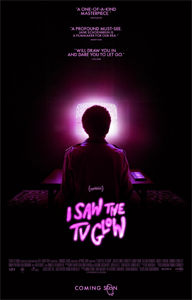“I Saw the TV Glow” is one of the weirdest movies I’ve ever liked. This neon-lit, wrongly categorized “horror” movie from writer-director Jane Schoenbrun taps into pop-TV obsession as escapism, inability to be socially “normal,” the question of whether platonic friendship between males and females is possible, transgenderism, and the fast passage of time in the 21st century.
Featuring two teens mostly played by actors a decade too old (but that’s OK due to the overall oddness), “ISTTVG” is a visual equivalent of those collage-filled girls’ journals that pop up in teen rom-coms: nonsensical at first blush, but filled with a barrage of ideas. Portraits of unformed, but unquestionably alive, teens.
This film doesn’t actually showcase one of those journals, even though the teens have enough ennui to fill dozens. But the screen does superimpose locker notes and VHS tapes passed from Maddy (Brigette Lundy-Paine) – in ninth grade when we meet her — to Owen (Ian Foreman and Justice Smith) – in seventh grade when we meet him.
“I Saw the TV Glow” (2024)
Director: Jane Schoenbrun
Writer: Jane Schoenbrun
Stars: Justice Smith, Brigette Lundy-Paine, Ian Foreman
The real pull of the unreal
These late-1990s teens are fans of “The Pink Opaque,” but Owen has a dying mom and a nasty dad who won’t let him stay up to watch the 10:30 p.m. Saturday show. The transgender Schoenbrun gives a nod to their “Buffy” fandom by using “Buffy” typescript on the “Opaque” scenes (in grainy and square format), naming one of the show’s two superpowered girls Tara, and casting Amber Benson in a cameo.
“Opaque” is actually a cheap kids’ show like “Power Rangers,” but with references like “the Big Bad” and the girls being buried alive at the end of Season 5 and resurrected in Season 6, a “Buffy” fan can’t deny the parallels. But the specific show of Owen’s and Maddy’s obsession doesn’t matter (although the specificity is important to them, of course); the point is they immerse themselves in an alternate world because the reality of being an outcast at school, work and home doesn’t have the same appeal.
Rather than a lecture on the danger of such behavior (as in, for instance, “The Cable Guy”), “ISTTVG” does not take a negative conclusion for granted. Nor a positive conclusion. Certainly, though, “Opaque” is the catalyst for a friendship between two awkward teens who can’t do the standard social steps to make friends.
Often, this is sweet as hell. If Schoenbrun isn’t also riffing on “Napoleon Dynamite” – notably when Maddy openly and genuinely says “Ugh!” when reflecting on her former bestie dumping her for cheerleading – I’d be surprised. But generally, the movie doesn’t want laughs, it wants thoughtfulness, and achieves it.

It’s somehow not pretentious when Owen tells Maddy: “It feels like someone took a shovel and dug out all my insides. And I know there’s nothing in there, but I’m still too nervous to open myself up and check.”
Grounded by friendship
“ISTTVG” wisely starts with the Owen-Maddy friendship rather than being inaccessibly weird. So when it gradually gets metaphysical (fitting the 2024 trend, with “Caddo Lake” and “My Old Ass”), I was still in its grip. For Maddy, time is moving faster as she grows older, even (or because of?) the escape of “Opaque,” a world she now inhabits. (In a smart shot, she and Owen reunite at the “Opaque’s” music venue, Double Lunch, in widescreen format, perhaps indicating the merging of worlds.)
Owen has patiently waited to become “normal,” but it hasn’t happened. And now he can’t even escape into “Opaque,” because upon a rewatch – now via streaming, as the narrative moves near present day – he finds the show so crappy he’s embarrassed that he used to like it.
“ISTTVG” encourages a viewer to ask “Is the filmmaker into the material, or are they just throwing stuff at the screen?” I have no doubt this director is into it. So even in indulgent interludes like Double Lunch band Sloppy Jane playing the gorgeously ephemeral “Claw Machine,” I try to think of thematic or narrative meanings.
Schoenbrun hits us with several profound and artistic moments, but more of a mysterious narrative thrust – even something barely there, like in “Vertigo” – could’ve pushed “I Saw the TV Glow” toward masterpiece status. It’s not at that level, but it’s a heady experience just letting its strange warm glow wash over you.

